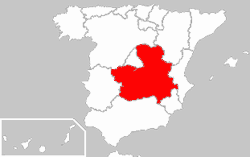Castilla–La Mancha
| |||||

| |||||
| Capital | Toledo | ||||
| Area – Total – % of Spain |
Ranked 3rd 79,463 km² 15.7% | ||||
| Population – Total (2005) – % of Spain – Density |
Ranked 9th 1,894 667 4.3% 23.84/km² | ||||
| Demonym – English – Spanish |
Castilian-Manchego castellano-manchego | ||||
| Statute of Autonomy | August 16, 1982 | ||||
| ISO 3166-2 | CM | ||||
| Parliamentary representation – Congress seats – Senate seats |
20 2 | ||||
| President | José María Barreda Fontes (PSOE) | ||||
| Gobierno de Castilla-La Mancha | |||||
Castile-La Mancha (Spanish Castilla-La Mancha) is an autonomous community of Spain.
Castile-La Mancha is bordered by Castile and León, Madrid, Aragon, Valencia, Murcia, Andalusia, and Extremadura. It is the most sparsely populated of Spain's autonomous communities.
The capital of Castile-La Mancha is Toledo.
Castile-La Mancha was formerly grouped with the province of Madrid into New Castile ("Castilla la Nueva"), but with the advent of the modern Spanish system of semi-autonomous regions (las autonomías), it was separated due to great economic disparity between the capital and the remaining New-Castilian provinces.
It is in this province where the famous Spanish novel Don Quixote by Cervantes takes place. Although La Mancha is a windswept, battered plateau (manxa means parched earth in Arabic; hence La Mancha is not definitively related to the Spanish word mancha, or stain, which is derived from Latin macula) it remains a symbol of the Spanish culture with its sunflowers, windmills, Manchego cheese and, of course, El Quijote.
La Mancha's history has been tumultuous. Going as far back as the Muslim domination of the Iberian peninsula, La Mancha was the center of many battles between Christian and Muslim forces. Moreover, this region saw many a struggle in the 14th and 15th century with the unification of Castile and Aragon in 1492 under Queen Isabel and King Ferdinand.
Castile-La Mancha is divided into 5 provinces named after their capital cities:
Other important towns in Castile-La Mancha (with more than 25 000 inhabitants) are:
- Talavera de la Reina, Toledo
- Puertollano, Ciudad Real
- Tomelloso, Ciudad Real
- Hellín, Albacete
- Alcázar de San Juan, Ciudad Real
- Valdepeñas, Ciudad Real


